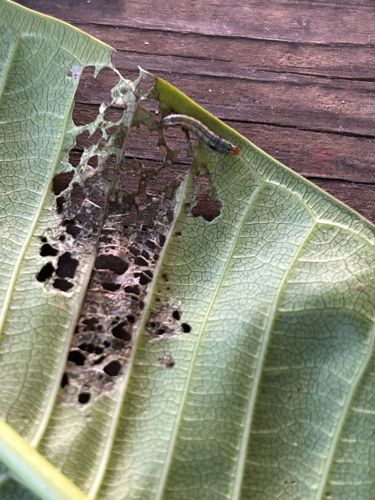Looper Caterpillar (tentative identification)
Scientific Name: Most likely from the family Geometridae, such as "green semilooper" like Chrysodeixis eriosoma or similar species within Noctuidae (e.g., Anomis spp.)
Order & Family: Order Lepidoptera, Family Geometridae or Noctuidae.
Size: Larvae typically range from 2 cm to 4 cm in length at maturity, though size varies significantly by species and instar.

Natural Habitat
Found in gardens, agricultural fields, and natural ecosystems where their host plants are present. They are primarily arboreal or ground-dwelling on vegetation.
Diet & Feeding
Herbivorous. These caterpillars feed on the leaves of a wide variety of plants, causing defoliation. The feeding damage in the image (holes and skeletonization) is typical of caterpillar feeding.
Behavior Patterns
The characteristic 'looping' or 'inchworm' movement (contracting and extending their body due to fewer prolegs) is a key behavior for Geometridae loopers. They undergo complete metamorphosis, having egg, larval (caterpillar), pupal, and adult (moth) stages. Many species are nocturnal feeders.
Risks & Benefits
Risks: Primarily a pest in agriculture and gardening, causing significant damage to crops and ornamental plants by defoliation, which can lead to reduced yields or plant death if infestations are severe. Benefits: Serve as a food source for birds, predatory insects, and other animals, contributing to the food chain. Adult moths can act as pollinators for some plants.
Identified on: 9/16/2025